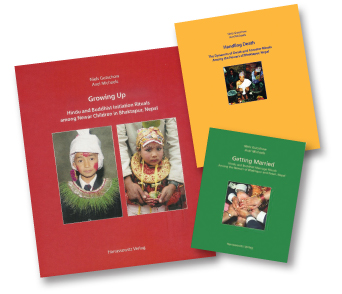A trilogy based on a 12-year research on Newari life cycle rituals arrives in the scholarly scene.
As I looked around that small crowd of gray and white heads gathered in the small courtyard of Yalamaya Kendra in Patan on the evening of March 13, 2013, I realized the word that the gathering evoked again and again was ‘decade(s)’. There were expatriates who had lived in Nepal for decades and there were scholars who had researched on some aspect of Nepal for decades. The people gathered there were mostly scholars, Nepalese as well as foreigners. I knew a few of them, others I had only read or heard about and was seeing for the first time. The occasion was a book launch organized by the Kathmandu Branch Office of the South Asia Institute (SAI) of Heidelberg University, Germany.

The trilogy being launched at the event itself had taken well over a decade to research. Entitled ‘Life Cycle Rituals in Nepal’, it was the result of a 12-year analysis funded by the German Research Foundation (DFG). Ritual Dynamics, the research center of the Heidelberg University, had implemented the project. Authored by architectural historian Niels Gutschow and Indologist Axel Michaels, the books deal with life-cycle rituals in Nepal. The first, second, and third volumes of the trilogy cover death and ancestor rituals, initiation rituals, and marriage rituals respectively. The rites described in the books were those of the Newars of Bhaktapur and Patan. Opening the event, His Excellency Frank Meyke, the German Ambassador to Nepal, remarked that the books were “a major contribution to the preservation of Newari culture.”
The first volume of the trilogy is titled Handling Death: The Dynamics of Death Rituals and Ancestor Rituals Among the Newars of Bhaktapur, Nepal, the second is Growing Up: Hindu and Buddhist Initiation Rituals Among Newar Children in Bhaktapur, Nepal, and the third volume is Getting Married: Hindu and Buddhist Marriage Rituals Among the Newars of Bhaktapur and Patan, Nepal. Axel Michaels, co-author of the trilogy, summarized his work by listing three aspects that the books cover: The dynamics of rituals; ethno-Indology aspect, and ritual transfer. Johanna Buss and Nutan Sharma also contributed to the first volume, and Manik Bajracharya, Christiane Brosius and Tessa Pariyar helped with the third book. The first and second volumes also have DVDs of films by Christian Bau. Beside descriptions and analysis of the rituals, the books also contain fascinating bonuses like the handbooks and manuals used by Brahmin and Vajracharya priests during the rites.
Niels Gutschow mentioned in his speech that the book was unique in that when speaking of the rituals and ceremonies, it names the people involved and the places where the events take place as well as recording the dates for the events. “This was a way to overcome the anonymity of the actors,” he said. The books are a gift to the posterity of Nepal, especially of the Newar community. It is sure to educate and delight readers with its detailed recording of the rich religious and cultural practices of the Newars.










